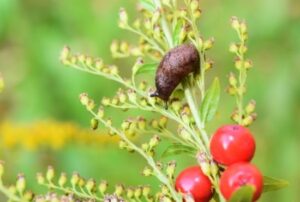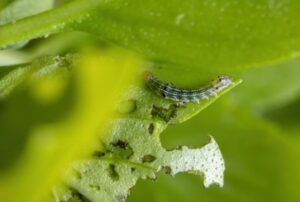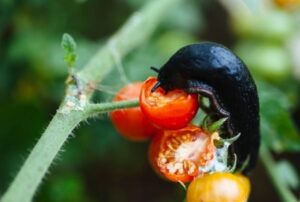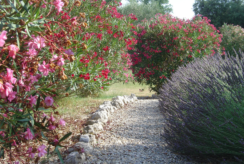If we could garden without any interference from the pests that attack plants, then gardening would be a simple matter. But all the time, we must watch out for these minor foes little in size but tremendous in the havoc they make.
As healthful conditions may often prevent human illness, pests may be kept away by strict garden cleanliness.
 Heaps of waste are lodging places for the breeding of insects. I do not think a compost pile will do them harm, but unkempt, uncared-for spots seem to invite trouble.
Heaps of waste are lodging places for the breeding of insects. I do not think a compost pile will do them harm, but unkempt, uncared-for spots seem to invite trouble.
There are specific helps to keep pests down. The constant stirring up of the soil by earthworms is an aid in keeping the soil open to air and water.
Many of our common birds feed upon insects. The sparrows, robins, chickadees, meadowlarks and orioles are all examples of birds who help in this way. Some insects feed on other and harmful insects.
Some kinds of ladybugs do this good deed. The ichneumon-fly helps too. And toads are wonders in the number of insects they can consume at one meal. The toad deserves very kind treatment from all of us.
Each gardener should try to make her or his garden into a place attractive to birds and toads. A good birdhouse, grain sprinkled about in early spring, a water-place, are invitations for birds to stay awhile in your garden. If you wish toads, fix things up for them too.
During a hot summer day, toads like to rest in the shade. By night they are ready to eat but not to kill since toads prefer live food.
How can one “set up” for toads? Well, one thing to do is to prepare a retreat, quiet, dark and damp. A few stones of some size underneath the shade of a shrub with perhaps a carpeting of damp leaves would appear very fine to a toad.
There are two general classes of insects known by the way they do their work. One kind gnaws at the plant, really taking pieces of it into its system.
This kind of insect has a mouth fitted to do this work. Grasshoppers and caterpillars are of this sort. The other type sucks the juices from a plant. This, in some ways, is the worst sort. Plant lice belong here, as do mosquitoes, which prey on us. All the scale insects fasten themselves on plants and suck out the life of the plants.
Now can we fight these chaps? The gnawing fellows may be caught with poison sprayed upon plants, which they take into their bodies with the plant—the Bordeaux mixture, which is a poison sprayed upon plants for this purpose.
In the other case, the only thing is to attack the insect direct. So certain insecticides, as they are called, are sprayed on the plant to fall upon the insect. They do a deadly work of attacking the body of the insect in one way or another.
Sometimes we are much troubled with underground insects at work. You have seen a garden covered with anthills. Here is a remedy, but one of which you must be careful.
This question is constantly being asked, ‘How can I tell what insect is doing the destructive work?’ Well, you can tell partly by the work done and partly by seeing the insect itself.
This last thing is not always so easy to accomplish. I had cutworms one season and never saw one. I saw only the work done. If stalks of tender plants are cut clean off, be pretty sure the cutworm is abroad.
What do they look like?
Well, that is a tricky question because they come from a large family.
 Should you sometimes see a greyish striped caterpillar, you may know it is a cutworm. But because of its habit of resting in the ground during the day and working by night, it isn’t easy to catch sight of one.
Should you sometimes see a greyish striped caterpillar, you may know it is a cutworm. But because of its habit of resting in the ground during the day and working by night, it isn’t easy to catch sight of one.
The cutworm is around early in the season, ready to cut the flower stalks of the hyacinths. When the peas come on a bit later, they are ready for them. A perfect way to block them off is to put paper collars, or tin ones, about the plants. These collars should be about an inch away from the plant.
Of course, plant lice are more common. Those we see are often green in colour. But they may be red, yellow or brown. Lice are easy enough to find since they are always clinging to their host. As sucking insects, they have to cling close to a plant for food, and one is pretty sure to find them. But the biting insects do their work and then hide. That makes them much more challenging to deal with.
Rose slugs do significant damage to the rose bushes. They eat out the body of the leaves so that just the veining is left. They are soft-bodied, green above and yellow below.
A beetle, the striped beetle, attacks young melons and squash leaves. It eats the leaf by riddling out holes in it. This beetle, as its name implies, is striped. The back is black with yellow stripes running lengthwise.
Then there are the slugs, which are garden pests. The slug will devour almost any garden plant, whether it be a flower or a vegetable. They lay lots of eggs in old rubbish heaps.
Slugs do more harm in the garden than almost any other single insect pest. There is a trick for bringing them to the surface of the ground in the day time. You see, they rest during the day below ground.
So water the soil in which the slugs are supposed to be. How are you to know where they are? They are quite likely to hide near the plants they are feeding on. So water the ground with some nice clean lime water. This will disturb them, and up they’ll poke to see what the matter is.
Besides these most common pests, pests that attack many kinds of plants are particular pests for unique plants.
Beans have pests of their own, so have potatoes and cabbages. The vegetable garden has many inhabitants. In the flower garden, lice are very bothersome, the cutworm and the slug have a good time there, too, and ants often get very numerous as the season advances.
But for real discouraging insect troubles, the vegetable garden takes the prize. If we were going into fruit to any extent, perhaps the vegetable garden would have to resign in favour of the fruit garden.
A common pest in the vegetable garden is the tomato worm. This is a large yellowish or greenish striped worm. Its work is to eat into the young fruit.
A great, light green caterpillar is found on celery. The black bands may tell this caterpillar one on each ring or segment of its body.
The squash bug may be discovered by its brown body, which is long and slender, and by the disagreeable odour when killed.
The potato bug is another fellow to look out for. It is a beetle with yellow and black stripes down its crusty back.
The little green cabbage worm is a perfect nuisance. It is a small caterpillar and smaller than the tomato worm. These are perhaps the most common of garden pests by name.




